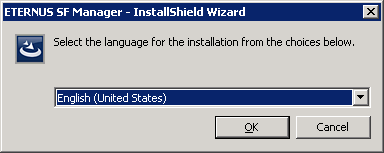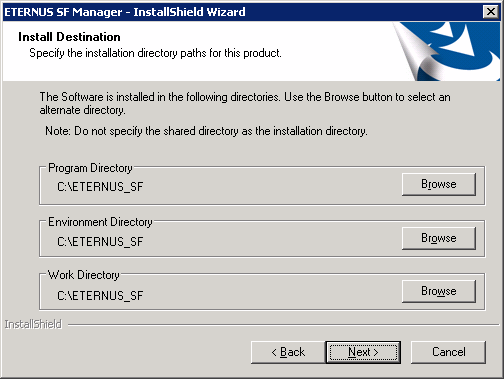There are two methods of performing the interactive installation of ETERNUS SF Manager (for Windows).
Default installation
The following configuration is used without the need to input any values.
Installation destination
The "systemDrive:\ETERNUS_SF" directory is used as the base location for the Program Directory, Environment Directory, and Work Directory.
Port numbers for the various communication services
9 port numbers are used, as follows.
Service | Display Name on [Port Registration] Screen | Used Port Number |
|---|---|---|
Web Console service | ETERNUS SF Manager Apache service | 9855 |
Communication service 1 | Communications service 1 | 1226 |
Communication service 2 | Communications service 2 | 4917 |
Repository service | Repository service | 15432 |
Internal use | Internal Port 1 | 28005 |
Internal Port 2 | 28009 | |
Internal Port 3 | 28443 | |
Internal Port 4 | 24916 | |
Internal Port 5 (No screen display) | 24917 |
Custom installation
Installation is done by entering the configuration information on the screen (installation destination, communication service port numbers).
Note
Do not rename, change, and delete the install directory after the installation.
During the installation of this product, the "esfpostgres" OS user account that the "Log on as a service" privilege is added is created.
The "esfpostgres" account is used to start the ETERNUS SF Manager Postgres Service, which is required to operate the ETERNUS SF system. For this reason, do not change the account information excluding the password and do not delete the account.
For changing the password, refer to "4.1.1.4 Esfpostgres User Password Change Procedure".
For Active Directory environments and when operating by defining the group policy "Log on as a service", add the account esfpostgres to the definition for "Log on as a service". Refer to the operating system manual for details on handling group policies.
When reinstall on Windows Server 2012 or later, if you change the port number of the following services of ETERNUS SF Manager, delete the following service names that are defined in the %SystemRoot%\system32\drivers\etc\services file, and then reinstall.
stgxfws
The interactive installation is performed as follows:
Log on to the server using Administrator privileges.
Information
Specify a user that corresponds to the using server type.
Server Type | User to Be Specified |
|---|---|
Domain Controller | Domain user |
Machine that belongs to the domain | Local user |
WORKGROUP (does not belong to the domain) |
Insert the DVD-ROM "ETERNUS SF SC/ACM/Express Mediapack for Windows (Manager Program) (1/2)" for this version into the DVD-ROM drive.
The following window is displayed. Click Manager installation.
To cancel the installation at this point, click Exit.

The following dialog box is displayed. Select the appropriate language and click OK.
The language selected in this dialog box is used during the installation and uninstallation.

The following progress bar is displayed. To cancel the installation, click Cancel.

The installation wizard page is displayed. Click Next.

Read the terms and conditions of the License Agreement page.
If the conditions are agreeable, select [I accept the terms of the license agreement] and then click Next.

Select the features and options to install from the Install option page.

Select [ETERNUS SF Manager is installed.].
Select the desired options according to the following information.
Install Option | Explanation |
|---|---|
Default | Changing values in the Installation Destination page and Port Registration page is optional. In this case, steps 9 and 10 can be skipped. For this installation method, the following checks are automatically performed relating to the information provided by default:
If an error is detected at this stage, a warning dialog box is displayed. |
Custom | The installation information must be manually entered in the pages for step 9 and later. |
Specify the installation directory in the Install Destination page.
If installing to a directory other than the default directory, click Browse and change the install location. After designating all of the directories, click Next.

Point
Spaces and the characters " | : * ? / . < > , % & ^ = ! ; # ' @ ( ) + are not supported for file name.
The number of characters in a directory name must be between 4 and 70.
Specify the port number for the services in the Port Registration page.

The default values are displayed. If necessary, enter alternative port numbers suitable for your environment. Values between 1024 and 65535 are valid.
When changing the port number for Internal Port 5, edit the %SystemRoot%\system32\drivers\etc\services file manually, and define the following service name and unused port number in the range 1024-65535.
Service Name | Port Number / Protocol | Used Purpose |
|---|---|---|
astm | 24917/tcp | This is used for the following purpose. |
For the IP address of Management Server (Self-system), specify the IPv4 address checked in "3.1.6 IP Address Confirmation".
Then, click Next. If an entered value is already being used, the page is displayed again.
Check the settings information in the Start Copying Files page.
If the settings are correct, click Next.
To change a setting, click Back.

Copying the program is started.
During this process, the file copy completion status is displayed in the Setup Status page.
When the copying process is completed, the system configuration is updated. Wait for the configuration update process to complete.

The following installation wizard page is displayed. The installation process is completed. Click Finish.

Eject the DVD-ROM.
The ETERNUS SF Manager (for Windows) installation is completed.
When linking VMware, following the above operation, install the ETERNUS VMware Support Package that was downloaded in "3.1.8 Download of ETERNUS VMware Support Package". Refer to the ETERNUS VASA Provider User's Guide for installation.